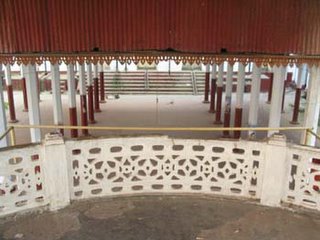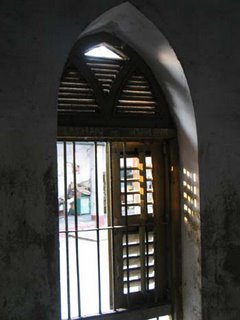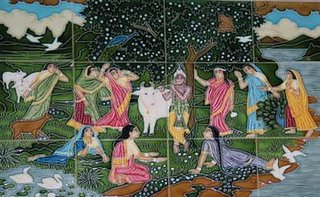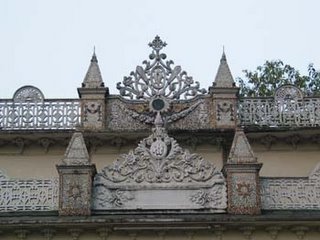Last weekend, I had the opportunity to explore the Bhawal Raja's grounds in the company of my friend Tutul's Mama who lives in Joydebpur. We explored the RajBari and the Shoshan, the two largest structures remaining. But the highlight of the trip was a private house belonging to a relative of Tutul's, which used to be the temple of the Raja's younger sister. Unlike the other structures, this house is well-preserved.
Why the fascination with Bhawal Raja? I heard the story of Bhawal from my mother when I was a child and it captured my imagination. Bhawal was a large Zamindari (estate) close to Dhaka with its headquarters in Joydebpur. In 1909, the heir to this estate, Raja Ramendra Narayan Roy, died in Darjeeling. The story involves the appearance, in 1922, of a Sadhu in Dhaka. When this Sadhu visited Joydebpur, many people thought he looked like Raja Ramendra Narayan Roy. These people included the Raja's own sister who was delighted to have her long-dead brother back.
Eventually a legal battle ensued over whether this Sadhu was really the Raja of Bhawal. On one side were the British government (who had taken over the estate at this point in time because of the lack of heirs) and the wife of the Raja. The other side consisted of the Sadhu, the Raja's sister as well as numerous others from Bhawal. The British side insisted that the Raja had died in Darjeeling and was cremated there. The Sadhu's side claimed he had not died; that his body was not cremated, but had been left just before cremation because of a storm; and that a nearby group of Sadhus had rescued and revived the Raja who went on to become a Sadhu.
Popular versions of the story cast more evi aspersions on the Raja's wife. It was alleged that she was having an affair with the Raja's doctor and the two of them conspired to have the Raja killed.
In the end, after 20+ years of legal wrangling, the Sadhu won the case and the property. However, two days after the final victory, he died of a stroke.
The case is revisited in the book "Princely Impostor?", by Partha Chatterjee, which I read last year. The book is fascinating if a tad too long, and after thorough research in archives in Dhaka, London and Calcutta, the author concludes that he cannot decide if the man who appeared after 12 years was indeed the Raja or an impostor.
Back to Joydebpur. The first stop was the RajBari. This has become a government office suite now, housing the District Commisioner's offices as well as various courts. Some parts of the building were locked because it was Friday, which is weekly holiday. But we were able to enter otherr parts and look around. Sadly this was the same building outside of which a suicide bomber killed several people in 2005.
The next stop was the Shoshan. When I saw it I thought it was a temple, because of the spires. As each Raja in the dynasty died, a his ashed were kept in a spot and a spire built around it. There were several spires, and the picture of one Raja (Ranendra Narayan Roy) was inside one of the spires. Overall the Shoshan was in a bad state of repair.
The final stop was Tutul's relative who lives in the Mondir of the King's sister. The family got this property as part of property exchange after Partition in 1947. This property had some beautiful tile work, nice external work, as well as beautiful wooden doors.
Lastly there was the Dighi (pond), with a Ghat that is now destroyed. The Ghat was Rani Shwarna Kumari's. A marble plaque announcing her name was still part of the old delapidated Ghat. It had pock marks from 1971, when Pakistani soldiers apparently went at it with their bayonets.
Many thanks to Tutul, Mukul, Zia and of course Mama for this encounter with a childhood fascination.
Now the pictures: First the palace courtyard.

This is the wing where the Rani lived:

Workmanship on the top floor of the Rajbari:

Platform on 2nd floor from which Raja spoke to subjects (on the ground floor)

Window of a room in the RajBari:

Spires of the Shoshan:

Picture of Raja Ranendra Narayan Roy inside the spire built around his ashes:

Tiles in the house that used to be Raja's sister's Mondir:

More tilework representing Krishna with Gopinis:

External work at the ex-Mondir:

Plaque on the Pukur Ghat:

sistunes
Saturday, February 4, 2006